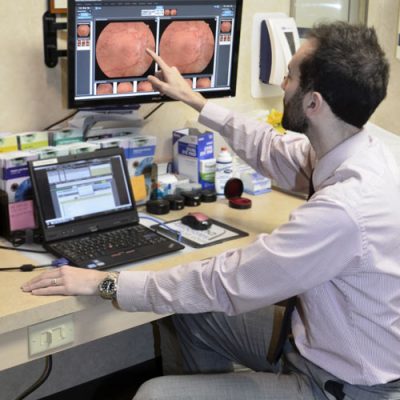Patient Examination
 A physician’s assistant will ask all patients to provide a thorough medical history, including all medications. On each visit, we will perform a vision test and a measurement of the intraocular pressure, followed by dilation of the eyes. After a wait to allow your pupils to dilate adequately, your physician will examine you.
A physician’s assistant will ask all patients to provide a thorough medical history, including all medications. On each visit, we will perform a vision test and a measurement of the intraocular pressure, followed by dilation of the eyes. After a wait to allow your pupils to dilate adequately, your physician will examine you.
Sometimes we may request additional testing to be performed and we will interpret these tests during the same visit.
We suggest that you bring someone to drive you home since your eyes will remain dilated for several hours. Sunglasses may help reduce glare; if you need some, please ask at the front desk before you leave.
We provide a full range of testing at all of our offices using the latest technology and equipment, including:
Ophthalmic Fluorescein & Indocyanine Green Angiography
Fluorescein and indocyanine green (ICG) angiography are diagnostic tests which use special cameras to photograph the structures in the back of the eye. These tests are very useful for finding leakage or damage to the blood vessels which nourish the retina. In both tests, a colored dye is injected into a vein in the arm of the patient. The dye travels through the circulatory system and reaches the vessels in the retina and the choroid.RASL Fundus Photography
Fluorescein angiography is used to diagnose and monitor progression of eye diseases such as diabetic retinopathy, vein occlusions, and macular degeneration. The eye is dilated for this test. Your eyes may be sensitive to light and your vision may be blurry due to the dilating drops and the flash photography. After the fluorescein dye is injected, your skin may turn yellowish for several hours, and your urine may turn orange or yellow for up to 24 hours. Indocyanine is a green dye which fluoresces with invisible infrared light deep choroidal vessels of the eye; it requires a special digital camera sensitive to these light rays.
Optical Coherence Tomography (OCT)
This test is a computerized ophthalmic imaging study that measures the thickness of the retina in cross-section. After your pupils are dilated, you will be asked to sit at the OCT machine with your chin on a chin rest and stare at a blinking light. Light waves from the machine rapidly scan across your retina and produce an image. This test is used to detect swelling or other structural defects in conditions such as macular degeneration, macular hole, diabetic retinopathy, retinal vein occlusion, RASL Servicesor epiretinal membrane.
“> Fundus Photography
This test is a photographic study of the back of the eye (the fundus) that helps to document the status of the retina, optic nerve, macula, blood vessels, and vitreous. Fundus photography is used to document the progression of eye diseases such as macular degeneration and diabetic retinopathy. No dye is required but the eye is usually dilated.
